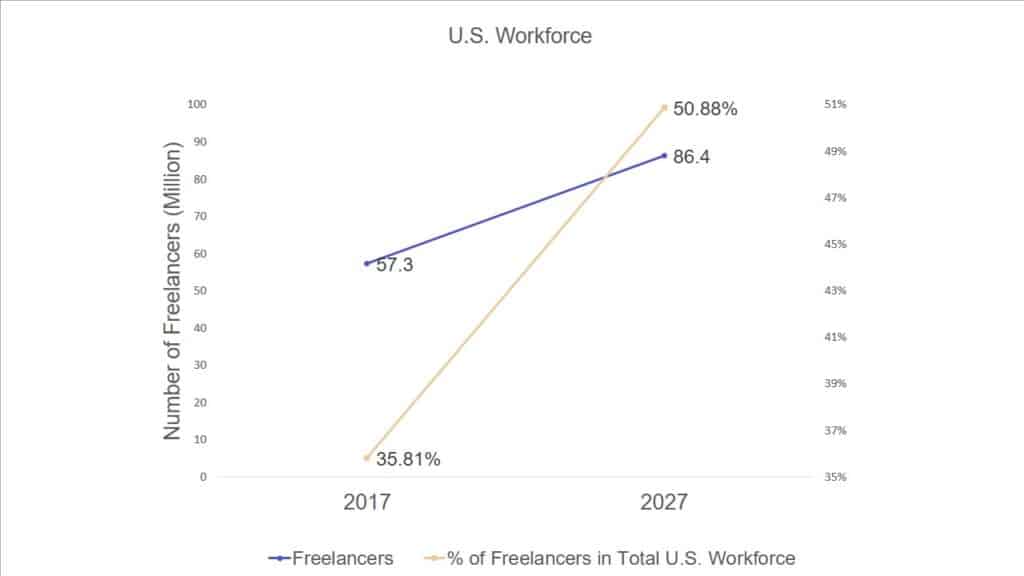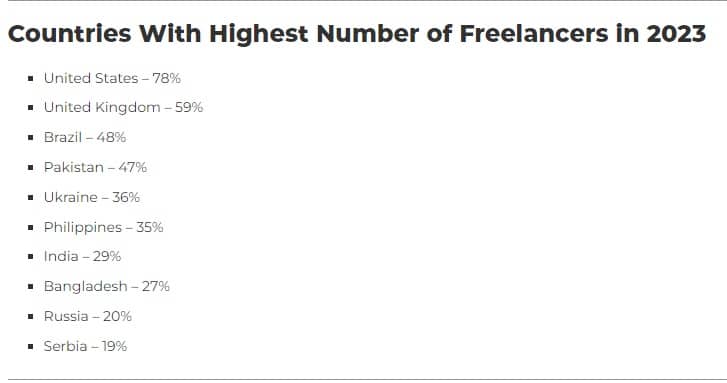
The global freelancing market is witnessing a remarkable upsurge, with a younger workforce taking the lead. Recent data reveals that nearly 47% of workers worldwide are now freelancers, comprising an estimated 1.57 billion people. Valued at $3.39 billion, this market is projected to reach $9.19 billion by 2027.
Digital platforms have played a pivotal role in this growth, providing opportunities for various skilled services. With freelancers earning an average of $21 per hour, this trend is reshaping the global workforce landscape, particularly among younger individuals.
Key Takeaways
- Nearly half of the global workforce consists of freelancers, with an estimated 1.57 billion people engaging in freelance work.
- The global freelance platform market is valued at $3.39 billion and is projected to reach $9.19 billion by 2027.
- Freelancers earn an average of $21 per hour globally, with specialized freelancers in fields like web/mobile development and marketing earning $28 per hour on average.
- The freelance industry is witnessing significant growth, with countries like the Philippines, India, and Japan experiencing high year-over-year growth rates in freelance revenue
What is Freelancing & Gig Economy
Freelancing and the gig economy signify a paradigm shift in work culture, emphasizing flexibility and autonomy. Freelancers operate independently, offering their skills and services to various clients or companies without being tied to a single employer. This model enables professionals to choose the projects they work on, set their schedules, and often work remotely.
On the other hand, the gig economy encompasses short-term or on-demand work, where individuals take up temporary tasks or projects, often facilitated through online platforms. It includes services like ride-sharing, food delivery, freelance writing, graphic design, and more.
The significance of freelancing and the gig economy has soared globally due to several factors. Technological advancements have fostered the creation of digital platforms that connect freelancers with clients across the world, breaking geographical barriers.
Moreover, companies increasingly value flexibility and cost-effectiveness, leading them to hire freelancers for specific projects rather than maintaining full-time staff. This shift has driven the growth of freelancing as a viable career choice, offering diverse opportunities and allowing individuals to curate their work-life balance.
For individuals exploring career paths or seeking a balanced lifestyle, freelancing and the gig economy offer an array of opportunities. The flexibility inherent in these models allows individuals to pursue multiple interests, control their schedules, and adapt work to their lifestyles.
Read the review of Toptal for startups and SMBs
Global Freelancing Market Overview & Stats
The global freelancing market is experiencing a significant boom, fuelled by a younger workforce leading the way. With surging demand for flexible work arrangements and the rise of digital platforms, freelancers are finding lucrative opportunities across various industries.
High paying industries such as web/mobile development, marketing, legal, accounting, and other skilled services are attracting freelancers who can command average hourly rates of $28.
In the US, programmers, data analysts, and mobile developers can earn up to $120,000 annually. This trend is not limited to a specific region, as countries like the United States, United Kingdom, Brazil, India, and Bangladesh are witnessing substantial growth in freelancing revenues.

As the market for skilled freelancers continues to expand, the global freelance platform market is projected to reach $9.19 billion by 2027.
1. Surging Demand
Fueling the global freelancing boom, the surging demand for flexible work arrangements and the rise of digital platforms have created lucrative opportunities for freelancers across various industries.
The COVID-19 pandemic has further accelerated this trend, as organizations increasingly rely on remote workers to adapt to the new normal. Freelancers offer businesses the flexibility to scale their workforce according to demand, while also bringing specialized skills and expertise.
However, freelancers in the gig economy face unique challenges such as income instability, lack of benefits, and difficulty in finding consistent work. Additionally, competition is fierce, and freelancers must constantly update their skills to stay relevant in a rapidly changing market.
Despite these challenges, the demand for freelancers continues to rise, driven by the need for flexibility and cost-effectiveness in a rapidly evolving global economy.
| Challenges Faced by Freelancers | Impact of COVID-19 |
| Income instability | Increased demand for remote work |
| Lack of benefits | Economic uncertainty |
| Difficulty in finding consistent work | Business cost-cutting measures |
2. Growth in the Freelance Platform Market
Further driving the global freelancing boom, the impressive growth in the freelance platform market has provided the younger workforce with abundant opportunities in various industries. The freelancer platform growth has been fueled by technological advancements and the increasing preference for flexible work arrangements.
These platforms have revolutionized the way work is done, allowing individuals to connect with clients from all over the world and showcase their skills and expertise.
Freelancing statistics show that fulltime self employed workers participate in the labor market with 28% (up from 17% in 2014). According to research on online freelancing platforms, Fiverr estimates that their total addressable market is $115 billion, Upwork estimates that their total addressable market is $560 billion. Toptal has reached the market share of 77.70% in engineer-recruiting market, which is huge!
The impact of the younger workforce on this growth cannot be underestimated. With their tech-savviness and entrepreneurial spirit, they have embraced freelancing as a viable career option and have been instrumental in shaping the future of work. This demographic has been quick to adapt to digital platforms, leveraging their skills to offer innovative solutions and drive innovation in the freelance economy.
As the freelance platform market continues to expand, it presents a promising landscape for the younger generation, enabling them to build successful careers on their own terms.
Impact of Remote Work Culture on Productivity- Read Here
3. Lucrative Earnings for Freelancers
As the global freelancing boom continues, freelancers are reaping the rewards with lucrative earnings in various industries. Factors affecting freelance wages include experience, skills, specialization, and demand for services.
Skilled freelancers in web/mobile development, marketing, legal, accounting, and other specialized services can earn an average of $28 per hour. Technical expertise and specialization tend to command higher wages in the freelance market.
In the United States, programmers, data analysts, and mobile developers can earn average annual salaries of up to $120,000. The market for skilled freelancers is growing, providing opportunities for higher earnings.
Additionally, the growth of the freelance platform market, currently worth $3.39 billion, is projected to reach $9.19 billion by 2027, further contributing to the potential for lucrative earnings for freelancers.
High-Paying Freelance Industries
The high-paying freelance industries offer lucrative opportunities for skilled professionals. As the global freelancing market continues to grow, there are emerging freelance markets that are particularly rewarding for freelancers.
Industries such as technology, finance, and healthcare are known to provide high-paying freelance jobs. In the technology sector, freelance web and mobile development, data analysis, and cybersecurity are in high demand and command premium rates.
Finance-related freelance jobs such as accounting, financial consulting, and investment analysis also offer attractive compensation. Additionally, the healthcare industry is witnessing a surge in demand for freelance medical writing, telemedicine services, and healthcare consulting.
These high-paying freelance industries not only provide financial stability but also allow professionals to work independently and explore their entrepreneurial spirit. With the increasing trend of remote work, the opportunities in these industries are expected to continue growing in the coming years.
4. Regional Hotspots for Freelancing
Regional hotspots for freelancing include countries like the United States, United Kingdom, Brazil, Pakistan, African Nations, Philippines, India, Bangladesh, Ukraine, Russia, and Serbia, which have shown significant growth in freelance earnings and opportunities. These countries have developed thriving regional freelance ecosystems, attracting a large number of freelancers and providing a conducive environment for their work.
The impact of freelancing on the economy of these regions cannot be underestimated. Freelancers contribute to the economy by generating income, creating job opportunities, and driving innovation. They bring diverse skills and expertise to the table, fueling the growth of industries such as technology, creative services, and consulting.
Top Countries for Freelancers
One of the top countries for freelancers is the United States, known for its thriving freelance ecosystem and high earning potential. The US offers a wide range of opportunities for freelancers across various industries, including technology, design, writing, and consulting. With a robust economy and a large number of top freelancing platforms such as Upwork, Fiverr, and Toptal, the country provides a fertile ground for freelancers to find clients and secure well-paying projects.

In addition to the United States, there are several emerging freelancing markets around the world that are attracting freelancers with their growing opportunities and supportive ecosystems. Countries like Brazil, Pakistan, Bangladesh, and India are witnessing significant growth in their freelance markets, offering freelancers a chance to tap into new client bases and explore diverse projects. These emerging markets provide freelancers with the potential to expand their networks, gain valuable experience, and increase their earning potential.
5. Younger Workforce Dominates Freelancing
The dominance of the younger workforce in the global freelance market is evident, with over two-thirds of freelancers worldwide being under the age of 35. This trend can be attributed to the impact of remote work on the younger workforce.
Millennials (born between 1981-1996) and Gen-Z (born between 1997-2012) represent the majority of the global freelance workforce, with nearly 70% under the age of 35.
In Asia, 82% of freelance workers are 35 y.o. or younger. In North America, less than half of freelancers are under 35.
The ability to work from anywhere in the world has opened up new opportunities for young professionals to pursue freelancing as a career path. However, despite the advantages of freelancing, younger freelancers also face challenges in the gig economy. These challenges include competition from more experienced freelancers, difficulty in building a strong client base, and the need to constantly update their skills to stay relevant in a rapidly changing market. Despite these challenges, the younger workforce continues to dominate the freelancing industry, driving innovation and shaping the future of work.
Read the review of Fiverr for Buyers
6. Education Level of Freelancers
The education level of freelancers plays a crucial role in shaping the global freelance market, with over half of freelancers having a postgraduate education. This high level of education among freelancers highlights their expertise and specialized skills, which are in high demand in today’s rapidly evolving job market.
In 2020, the proportion of freelancers with post-graduate education surged by 6%, constituting 51% of the freelance workforce. Conversely, those with a high school education or lower decreased by 6%, accounting for 31% of freelancers, marking a decline from the 2019 figures
The impact of freelancing on the traditional job market is significant, as it provides opportunities for highly educated individuals to work independently and on their own terms. This shift towards freelancing has disrupted traditional employment patterns, as more professionals choose to leverage their skills and knowledge through freelancing platforms.
As the freelance market continues to grow, it is important for traditional job markets to adapt and create flexible employment opportunities that cater to the changing needs and preferences of the workforce.
7. Gender Breakdown in the Freelance Workforce
Approximately what percentage of the freelance workforce is comprised of women? The gender breakdown in the freelance workforce shows an interesting pattern. While women continue to have a greater presence in the European freelance workforce, globally, the distribution is more evenly balanced.
In Europe, 65% of freelancers are men, and 35% are women. This gender diversity in the freelance workforce has a significant impact on the economy. It promotes inclusivity and provides opportunities for women to contribute their skills and expertise.
Additionally, the growing number of women in freelancing indicates a shift towards more flexible work arrangements and greater work-life balance.
Frequently Asked Questions (FAQ)
What Are the Top 5 Countries With the Highest Year-Over-Year Growth in Freelance Revenue in 2020?
The top 5 countries with the highest year-over-year growth in freelance revenue in 2020 were the Philippines, India, Japan, Australia, and Hong Kong. The impact of COVID-19 on the global freelance industry has accelerated this growth. The top freelancing platforms in these countries have played a crucial role in facilitating this expansion.
What Is the Average Hourly Wage for Freelancers Worldwide?
The average hourly wage for freelancers worldwide varies depending on the industry and specialization. On average, freelancers earn around $21 per hour, with skilled professionals in web/mobile development, marketing, legal, and accounting earning approximately $28 per hour.
What Are the Highest-Paying Freelance Industries?
The highest-paying freelance industries include tech and finance. These sectors offer lucrative opportunities for skilled freelancers due to their high demand for specialized expertise and the innovative nature of their work.
Wrapping Up
In conclusion, the global freelancing market is experiencing a significant boom, with younger individuals leading the way. The market is valued at billions of dollars and is projected to continue growing in the coming years. Freelancing on digital platforms offers opportunities for various skilled services and allows individuals to earn lucrative wages. The rise of freelancing among younger individuals, combined with their increasing education levels, is reshaping the global workforce landscape.








